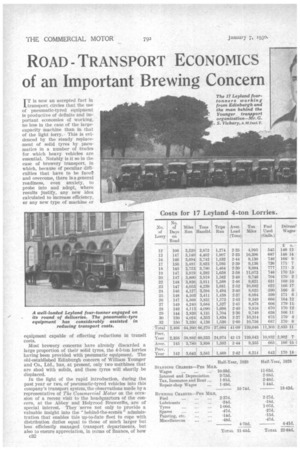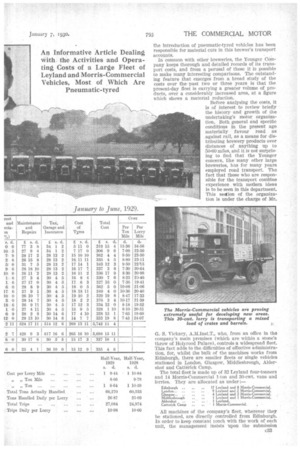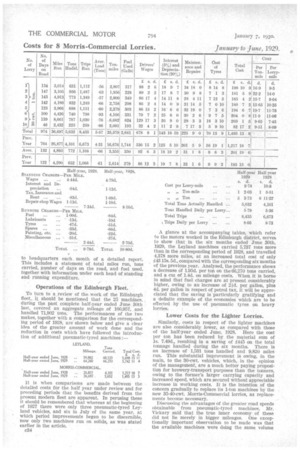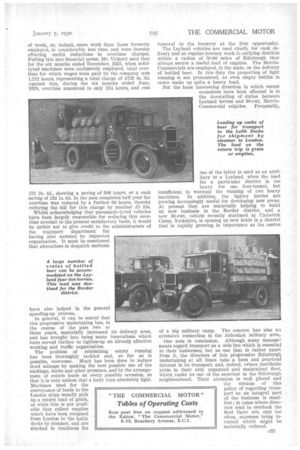ROAD TRANSPORT ECONOMICS
Page 54

Page 55

Page 56

Page 57

If you've noticed an error in this article please click here to report it so we can fix it.
of an Important Brewing Concern
TT is now an accepted fact in transport circles that the use of pneumatic-tyred equipment is productive of definite and important economies of working, no loss in the case of the largecapacity machine than in that of the light lorry. • This is evidenced by the steady replacement of solid tyres by pneumatics in a number of trades for which heavy vehicles are essential. Notably is it so in the case of brewery transport, in which, because of peculiar difficulties that have to be face(' and overcome, there is a general readiness, even anxiety, to probe into and adopt, where results justify, any new idea calculated to increase efficiency, or any new type of machine or equipment capable of effecting reductions in transit costs.
Most brewery concerns have already discarded a large proportion of their solid tyres, the 4-5-ton lorries having been provided with pneumatic equipment. The old-established Edinburgh concern of William Younger and Co., Ltd., has, at present, only two mathines that are shod with solids, and these tyres will shortly be displaced.
In the light of the rapid introduction, during the past year or two, of pneumatic-tyred vehicles into this company's transport system, the observations made by a representative of The Commercial Motor on the occasion of a recent visit to the headquarters of the concern, at the Abbey and Holyrood Brewerits, are of special interest. They 'serve not only to provide a valuable insight into the "behind-the-scenes" administration that enables this up-to-date fleet to cope with distribution duties equal to those of much larger but less efficiently managed transport departments, but also to ensure appreciation, in terms of finance, of how
032 the Introduction of pneumatic-tyred vehicles has been responsible for material cuts in this brewer's transport accounts.
In common with other breweries, the Younger Company keeps thorough and detailed records of its transport costs, and from a perusal of these it is possible to make many interesting comparisons. The outstanding feature that emerges from a broad study of the costs over the past two or three years is that the present-day fleet is carrying a greater volume of products, over a considerably increased area, at a figure which shows a material reduction.
Before analysing the costs, it is of interest to review briefly the history and growth of the undertaking's motor organization. Both general and specific conditions in the present ago materially favour road as against rail, as a means for distributing brewery products over distances of anything up to 50-60 miles, and it is not surprising to find that the Younger concern, like many other large breweries, has for many years employed road transport. The fact that those who are responsible for the transport combine experience with modern ideas is to be seen in this department. This section of the organization is under the charge of Mr.
G. S. Vickary, A.M.Inst.T., who, from an office in the company's main premises (which are within a stone's throw of Holyrood Palace), controls a widespread fleet. This fact adds to the difficulties of effective administration, for, whilst the bulk of the machines works from Edinburgh, there are smaller fleets or single vehicles stationed in London, Glasgow, Middlesbrough, Aldershot and Catterick Camp.
The total fleet is made up of 32 Leyland four-tonners and 14 Morris-Commercial 1-ton and 30-cwt. vans and lorries. They are allocated as under:— All machines of the company's fleet, wherever they be stationed, are directly controlled from Edinburgh. In order to keep constant touch with the work of each unit, the management insists upon the submission
to headquarters each month of a detailed report. This includes a statement of total miles run, tons carried, number of days on the road, and fuel used, together with information under each head of standing and running expenditure.
Operations of the Edinburgh Fleet.
To turn to a review of the work of the Edinburgh fieet, it Should be mentioned that the 25 machines, during the past complete half-year ended June 30th last, covered an aggregate _mileage of 100,957, and handled 71,902 tons. The performances of the two makes, together with a comparison for the corresponding period of 1928, are shown below and give a clear Idea of the greater amount of work done and the reduction in costs which have followed the introduction of additional pneumatic-tyred machines :
It is when comparisons are made between the detailed costs for the half year under review and for preceding periods that the benefits derived from the present modern fleet are apparent. In perusing these it should be remembered that whereas at the beginning of 1927 there were only three pneumatic-tyred Leyland vehicles, and six in July of the same year, at which period improvements began to be discernible, now only two machines run on solids, as was stated earlier in the article.
A glance at the accompanying tables, which refer to the motors worked in the Edinburgh district, serves to show that in the six months ended June 30th, 1929, the Leyland machines carried 5,737 tons more than in the corresponding period of 1928, and travelled 4,378 more miles, at an increased total cost of only £43 15s. 50., compared with the corresponding six months of the previous year. Analysed, the performance shows a decrease cif 1,95d. per ton on the 06,270 tons carried, and a cut of 1.4d. on mileage costs. When it is borne in mind that fuel charges are at present considerably higher, owing to an increase of 21sd. per gallon, plus 44. per gallon in respect of petrol tax, it will be appreciated that the saving is particularly gratifying and a definite example of the economies which are to be effected by the use of pneumatic tyres on heavy lorries.
Lower Costs for the Lighter Lorries.
Similarly, costs in respect of the lighter machines are also considerably lower, as compared with those of the half-year ended June, 1928. Here the cost per ton has been reduced by the material sum of Is, 7.49d., resulting in a saving of £445 on the total tonnage handled during the six months. There is an increase of 1,531 tons handled and 9,820 miles run. This substantial improvement is owing, in the main, to the 30-cwt. vehicles, which, in the opinion of the management, are a much better paying proposition for brewery-transport purposes than the tonners, owing to the former's larger carrying capacity and increased speed, which are secured without appreciable increase in working costs. It is the intention of the concern gradually to replace its 1-ton machines by the new 35-40-cwt. Morris-Commercial lorries, as replacements become necessary.
Discussing the advantages of the greater road speeds obtainable from pneumatic-tyred machines, Mr. Vickary said that the true inner economy , of these did not lie merely in bigger mileages. One exceptionally important observation to be made was that the available machines were doing the same volume of 'work, or, indeed, more work than those formerly employed, in considerably less time, and were thereby effecting useful reductions in overtime charges. Putting this into financial terms, Mr. Vickary said that for the six months ended December, 1925, when solidtyred machines were exclusively employed, total overtime for which wages were paid by the company wtrs 1,212 hours, representing a total charge of £123 4s. 3d. Against this, during the six months ended June, 1928, overtime amounted to only 314 hours, and cost £31 2s. 4d., showing a saving of 908 hours, or a cash saving of £92 is. 6d. In the past completed half year the overtime was reduced by a further 60 hours, thereby reducing the bill for this charge by another £5 15s.
Whilst acknowledging that pneumatic-ty red vehicles have been largely responsible for reducing this overtime account to the present satisfactory basis, it would be unfair not to give credit to the administrators of the transport department for having also assisted by improved organization. It must be mentioned that alterations in despatch methods
have also helped in the general speeding-up process..
In general, it can be stated that this progressive undertaking has, in the course of the past two or three years, materially increased its delivery area, and has brought into being many innovations which have served further to tighten-up an already effective working and traffic organization. removal to the brewery at the first opportunity.
The Leyland vehicles are used chiefly for cask delivery and on regular-journey work to outlying districts within a radius of 50-60 miles of Edinburgh they always secure a useful load of empties. The MorrisCommercials are employed, in the main, on the delivery of bottled beer. In this duty the proportion of light running is not pronounced, as even empty bottles in cases make up quite a heavy load.
Not the least interesting direction in which recent economies have been effected is in the dovetailing of duties between Leyland lorries and 30-cwt. MorrisCommercial vehicles. Frequently, one of the latter is used as an auxiliary to a Leyland, when the load for a particular district is too heavy for one four-tonner, but insufficient to warrant the running of two heavy machines. In addition, the lighter lorries are proving increasingly useful for developing new areas. At present they are materially helping to build up new business in the Border district, and a new 30-cwt. vehicle recently stationed at Catterick Camp, Yorkshire, is opening up new fields in a district that is rapidly growing in importance as the centre of a big military camp. The concern has also ari extensive connection in the Aldershot military area.
One note in conclusion. Although many managel ments regard transport as a side line which is essential to their businesses, but as one that is rather apart from it, the directors of this progressive Edinburgh undertaking at all times take a keen and practical interest in its transport, and, indeed, evince justifiable pride in their ably organized and maintained fleet, which ranks as one of the smartest in the Edinburgh neighbourhood. Their attention is well placed and the wisdom of this policy of regarding transport as an integral part of the business is manifest; in cases where directors tend to overlook the fleet there are, only too often, expenses being incurred which might be materially reduced.












































































































